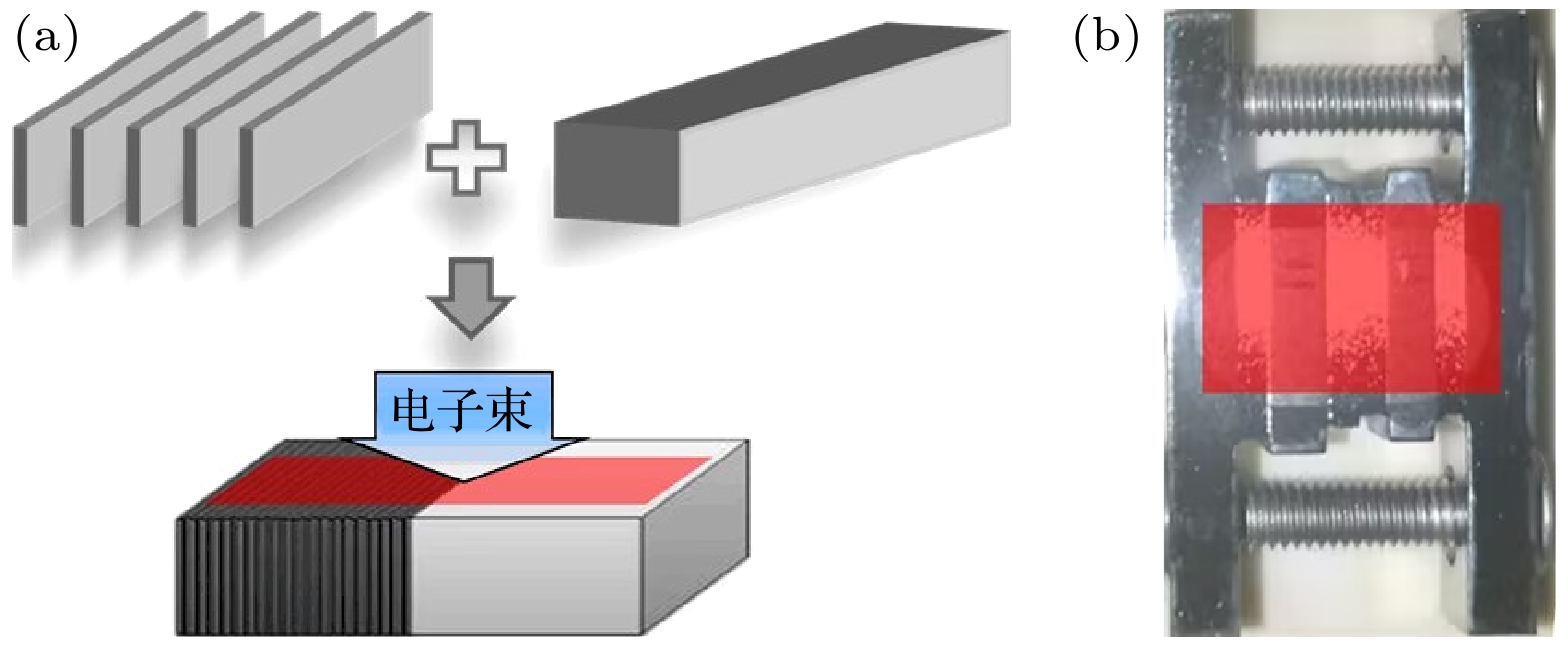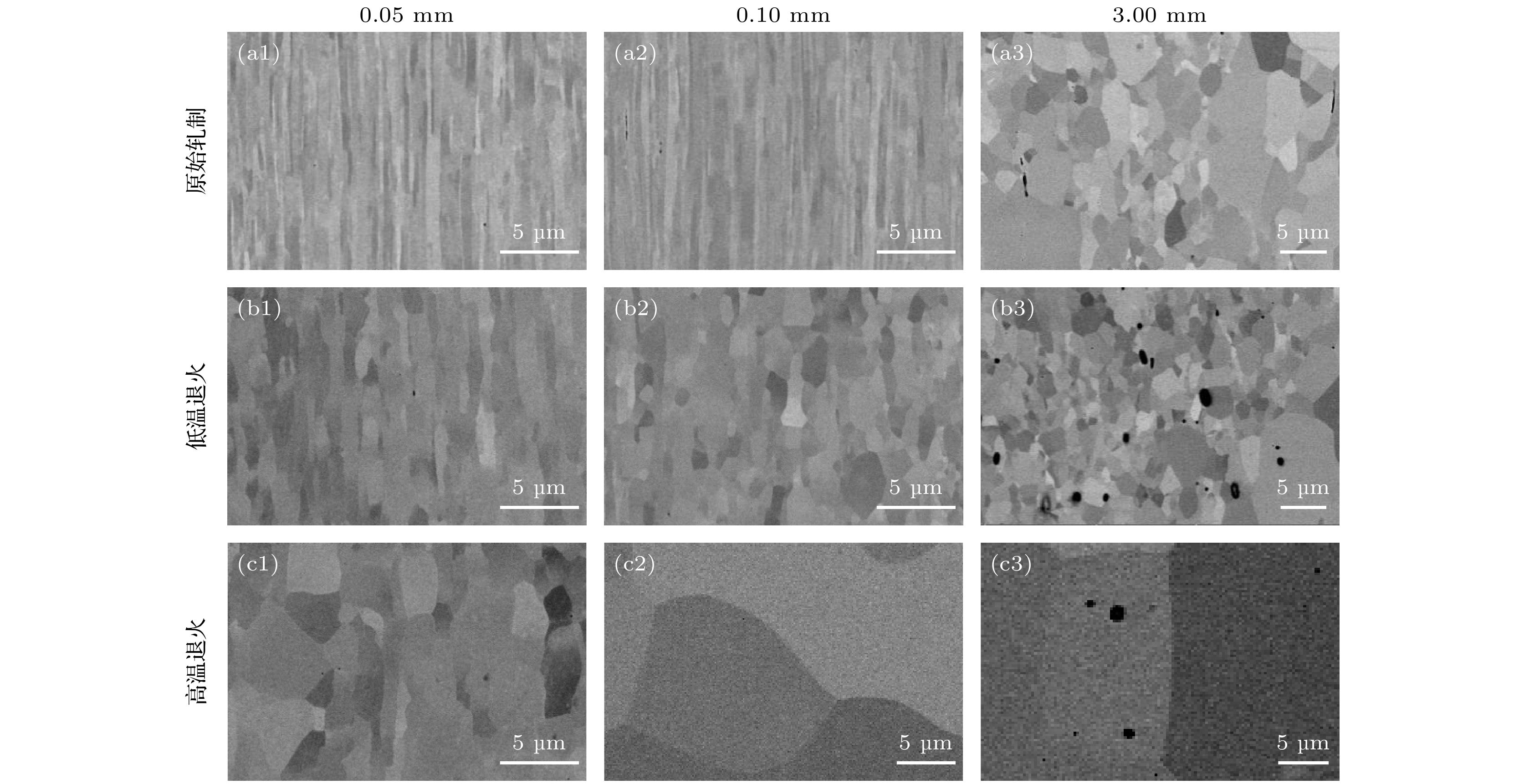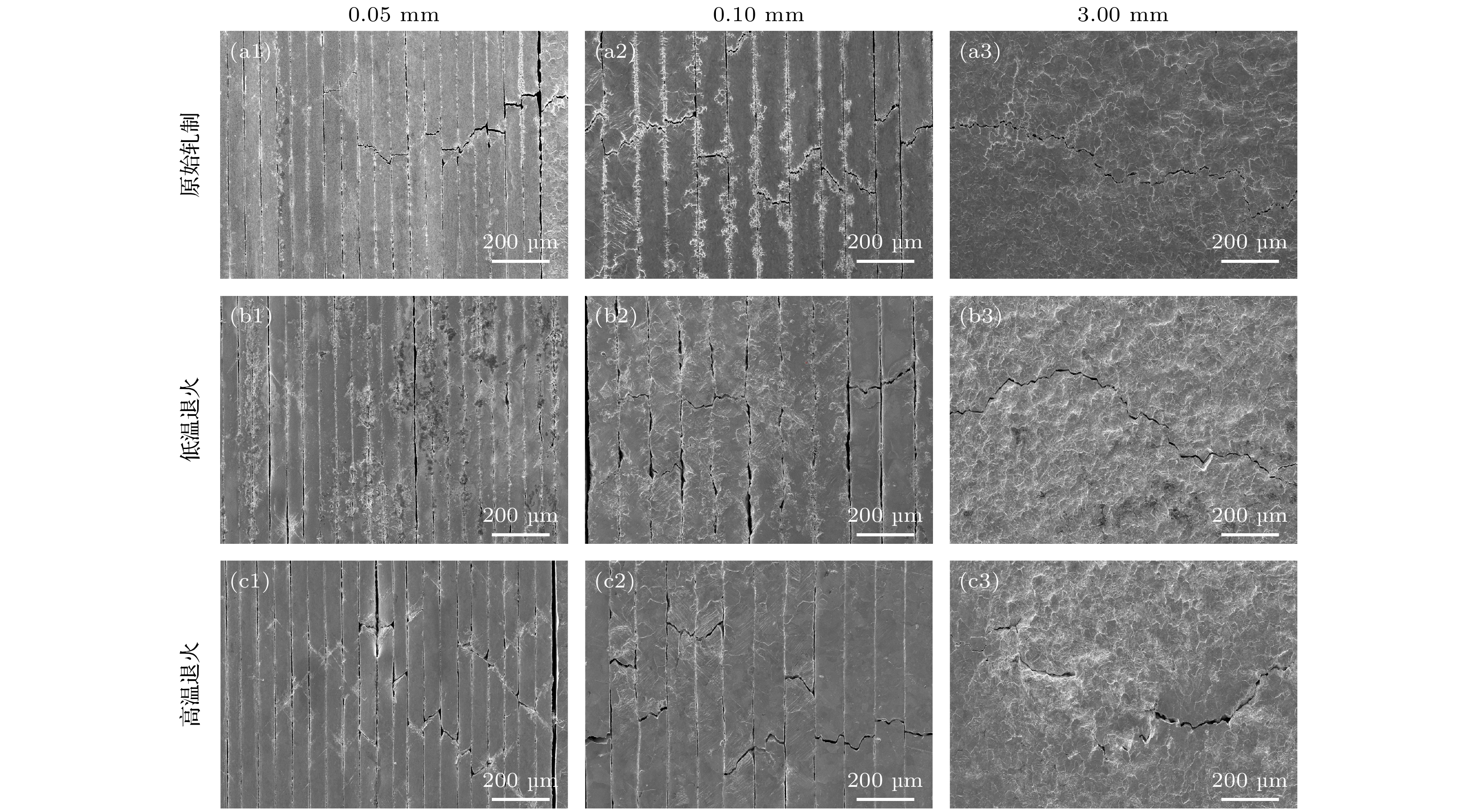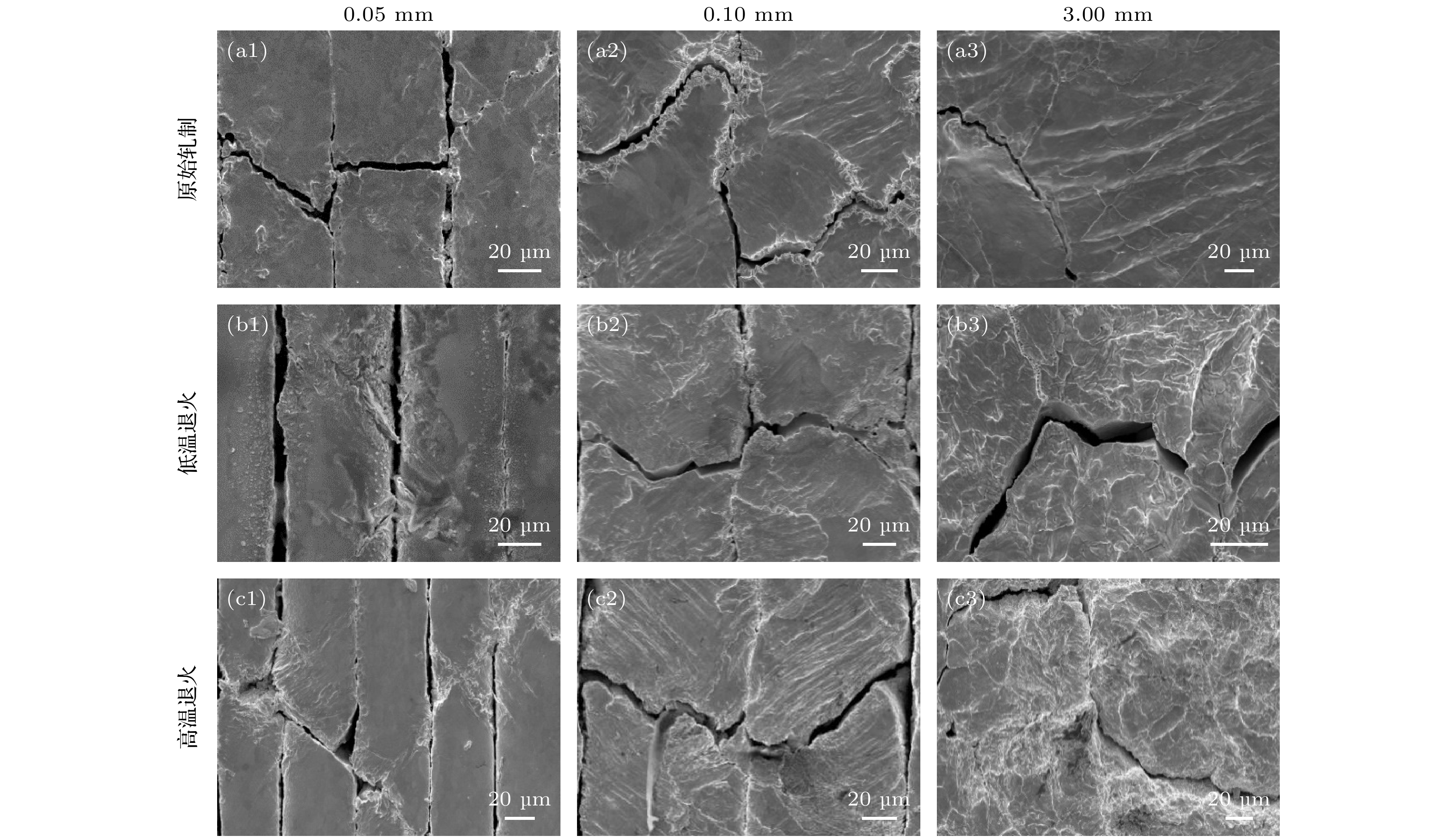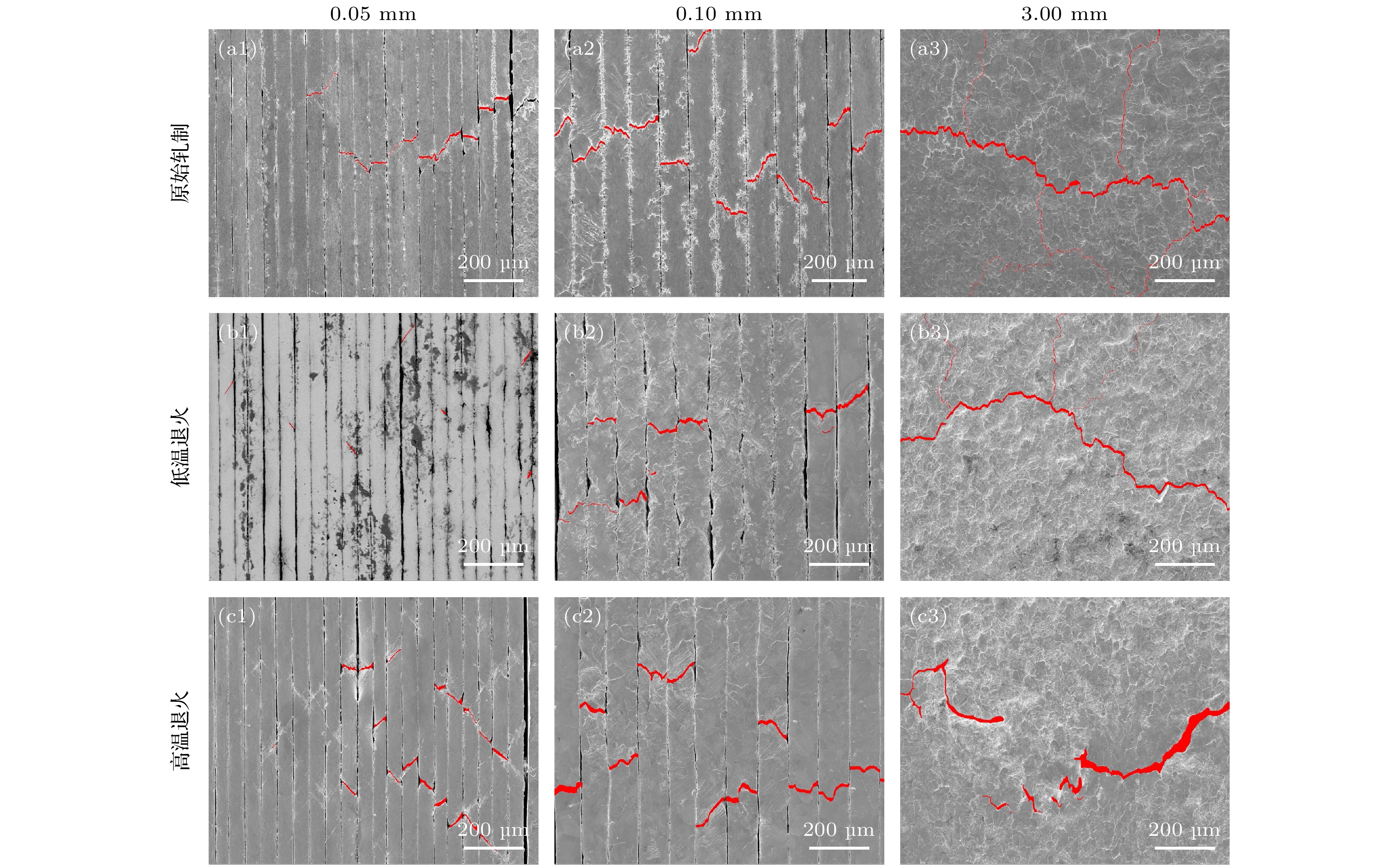-
The response of tungsten (W) to thermal shock loading, as the best candidate for plasma-facing material (PFM), is an important issue in the research of future fusion devices. Under thermal loading, thermal irradiation damage, including brittle cracking and fatigue cracking, occurs on the surface of tungsten based plasma-facing material (W-PFM). In this work, a new scheme to suppress the thermal irradiation damage to W-PFM, i.e. the laminated structure W-PFM scheme, is proposed. Thermal fatigue experiments of laminated structure W composed of W foils with different thickness and heat treatment processes are carried out by using an electron beam device. The samples are subjected to thermal pulses with a power density of 48 MW/m2 for 5000 cycles. The results indicate that the crack damage to the surface of the laminated structure W decreases with the decrease of the thickness of W foils under the same heat treatment conditions. The main cracks are produced on the surface of laminated structure W after cyclic thermal loads have been all approximately parallel to the foil thickness direction. Only the main cracks appear on the surfaces of W foils with a smaller thickness, while crack networks develop on the surfaces of W foils with a larger thickness , in addition to the main cracks with a larger width. In the rolled state, the laminated structure W has the lowest degree of surface plastic deformation for the same thickness. The thermal fatigue crack damage to the surface is quantitatively analyzed by using computer image processing software and analysis software, and scanning electron microscope images of the thermal damage area are finally selected. It is found that the de-stressed state W has the smallest crack area and the smallest number of cracks for the same thickness, indicating that the de-stressed state W has the strongest resistance to irradiation damage. The experimental results also show that in addition to the effect of microstructure, both the uniaxial stress state and the crack-blocking mechanism of the laminated structured W-PFM contribute to the improvement of its thermal fatigue performance.
-
Keywords:
- fusion /
- plasma facing material /
- tungsten /
- thermal fatigue
[1] Zhang C, Wang K, Si R, Li J, Song C, Wu S, Yan B, Chen C 2023 Chin. Phys. B 32 113102
 Google Scholar
Google Scholar
[2] Xu C, Wan F R 2023 ActaPhys. Sin. 72 056801 [徐驰, 万发荣 2023 物理学报 72 056801]
 Google Scholar
Google Scholar
Xu C, Wan F R 2023 ActaPhys. Sin. 72 056801
 Google Scholar
Google Scholar
[3] Qin M F, Wang Y M, Zhang H Y, Sun J Z 2023 ACTA Phys. Sin. 72 245204 [秦梦飞, 王英敏, 张红玉, 孙继忠 2023 物理学报 72 245204]
 Google Scholar
Google Scholar
Qin M F, Wang Y M, Zhang H Y, Sun J Z 2023 ACTA Phys. Sin. 72 245204
 Google Scholar
Google Scholar
[4] Terra A, Sergienko G, Gago M, Kreter A, Martynova Y, Rasinski M, Wirtz M, Loewenhoff T, Mao Y, Schwalenberg D, Raumann L, Coenen J W, Moeller S, Koppitz T, Dorow-Gerspach D, Brezinsek S, Unterberg B, Linsmeier C 2020 Phys. Scr. 2020 014045
[5] Wirtz M, Linke J, Loewenhoff Th, Pintsuk G, Uytdenhouwen I 2017 Nucl. Mater. Energy 12 148
 Google Scholar
Google Scholar
[6] Wang L, Wang B, Li S D, Ma D, Tang Y H, Yan H 2016 Int. J. Refract. Met. Hard Mater. 61 61
 Google Scholar
Google Scholar
[7] Loewenhoff Th, Linke J, Pintsuk G, Thomser C 2012 Fusion Eng. Des. 87 1201
 Google Scholar
Google Scholar
[8] Pintsuk G, Prokhodtseva A, Uytdenhouwen I 2011 J. Nucl. Mater. 417 481
 Google Scholar
Google Scholar
[9] Linke J, Loewenhoff T, Massaut V, Pintsuk G, Ritz G, Rödig M, Schmidt A, Thomser C, Uytdenhouwen I, Vasechko V, Wirtz M 2011 Nucl. Fusion 51 073017
 Google Scholar
Google Scholar
[10] Garkusha I E, Landman I, Linke J, Makhlaj V A, Medvedev A V, Malykhin S V, Peschanyi S, Pintsuk G, Pugachev A T, Tereshin V I 2011 J. Nucl. Mater. 415 S65
 Google Scholar
Google Scholar
[11] Pintsuk G, Kühnlein W, Linke J, Rödig M 2007 Fusion Eng. Des. 82 1720
 Google Scholar
Google Scholar
[12] Wang Y, Wang H, Mi B, Zhao J, Zhang C 2023 J. Nucl. Mater. 583 154555
 Google Scholar
Google Scholar
[13] Wirtz M, Linke J, Loewenhoff T, Pintsuk G, Uytdenhouwen I 2016 Phys. Scr. T167 014015
 Google Scholar
Google Scholar
[14] Rieth M, Dudarev S L, Gonzalez De Vicente S M, et al. 2013 J. Nucl. Mater. 432 482
 Google Scholar
Google Scholar
[15] Wurster S, Baluc N, Battabyal M, Crosby T, Du J, García-Rosales C, Hasegawa A, Hoffmann A, Kimura A, Kurishita H, Kurtz R J, Li H, Noh S, Reiser J, Riesch J, Rieth M, Setyawan W, Walter M, You J H, Pippan R 2013 J. Nucl. Mater. 442 S181
 Google Scholar
Google Scholar
[16] Parkes N, Dodds R, Watson A, Dye D, Hardie C, Humphry-Baker S A, Knowles A J 2023 Int. J. Refract. Met. Hard Mater. 113 106209
 Google Scholar
Google Scholar
[17] Alam M E, Odette G R 2023 Nucl. Mater. Energy 36 101467
 Google Scholar
Google Scholar
[18] Yang T, Wang J, Feng F, Liu X, Youyun L, Xueyu G 2023 Fusion Eng. Des. 196 113991
 Google Scholar
Google Scholar
[19] Dang N, Lian Y, Song J, Dai S, Yan B, Fan F, Wang J, Liu X 2023 Int. J. Refract. Met. Hard Mater. 117 106415
 Google Scholar
Google Scholar
[20] Coenen J W, Mao Y, Sistla S, Riesch J, Hoeschen T, Broeckmann Ch, Neu R, Linsmeier Ch 2018 Nucl. Mater. Energy 15 214
 Google Scholar
Google Scholar
[21] Neu R, Coenen J W, Curzadd B, Gietl H, Greuner H, Höschen T, Hunger K, Lürbke R, Müller A, Riesch J, Schlick G, Siefken U, Visca E, You J 2023 Mater. Res. Express 10 116516
 Google Scholar
Google Scholar
[22] Terra A, Sergienko G, Tokar M, Borodin D, Dittmar T, Huber A, Kreter A, Martynova Y, Möller S, Rasiński M, Wirtz M, Loewenhoff Th, Dorow-Gerspach D, Yuan Y, Brezinsek S, Unterberg B, Linsmeier Ch 2019 Nucl. Mater. Energy 19 7
 Google Scholar
Google Scholar
[23] Wang B, Hu D Z, Ma D, Lu G H 2018 US10102928B2
[24] Wang B, Hu D Z, Ma D, Lu G H 2016 ZL201410117811. X
[25] Li S D, Wang B, Liu Y H, Qi Y F, Li M, Ma Y T 2018 Chin. J. Vac. Sci. Technol. 38 434
[26] Xiao S, Ma Y, Tian L, Li M, Qi C, Wang B 2020 Nucl. Mater. Energy 23 100746
 Google Scholar
Google Scholar
[27] Wu X C, Xu L P 2002 Phys. Test. Chem. Anal. A Physical Test. 38 14
-
图 3 W箔和块体W表面形貌 (a1), (b1), (c1) 0.05 mm, 轧制, 去应力和再结晶W; (a2), (b2), (c2) 0.1 mm, 轧制, 去应力和再结晶W; (a3), (b3), (c3) 3 mm, 轧制, 去应力和再结晶W
Figure 3. The morphology of W foil and bulk W: (a1), (b1), (c1) 0.05 mm, rolled, stress-free, and recrystallied W; (a2), (b2), (c2) 0.1 mm, rolled, stress-free, and recrystallied W; (a3), (b3), (c3) 3 mm: rolled, stress-free, and recrystallied W.
图 4 不同热处理工艺下的叠片结构W和块状W表面的热损伤形貌 (a1), (b1), (c1) 0.05 mm, 轧制, 去应力和再结晶W; (a2), (b2), (c2) 0.1 mm, 轧制, 去应力和再结晶W; (a3), (b3), (c3) 3 mm, 轧制, 去应力和再结晶W
Figure 4. Thermal damage morphology of laminated W and bulk W under different heat treatment processes: (a1), (b1), (c1) 0.05 mm, rolled, stress-free, and recrystallied W; (a2), (b2), (c2) 0.10 mm, rolled, stress-free, and recrystallied W; (a3), (b3), (c3) 3.00 mm, rolled, stress-free, and recrystallied W.
图 5 不同热处理工艺下的W箔和块体W表面热损伤区域的微观形貌 (a1), (b1), (c1) 0.05 mm, 轧制, 去应力和再结晶W; (a2), (b2), (c2) 0.10 mm, 轧制, 去应力和再结晶W; (a3), (b3), (c3) 3.00 mm, 轧制, 去应力和再结晶W
Figure 5. Micromorphology of thermal damage area on the surface of W foil and bulk W under different heat treatment processes: (a1), (b1), (c1) 0.05 mm, rolled, stress-free, and recrystallied W; (a2), (b2), (c2) 0.10 mm, rolled, stress-free, and recrystallied W; (a3), (b3), (c3) 3.00 mm, rolled, stress-free, and recrystallied W.
表 1 热处理工艺参数
Table 1. Heat treatment process parameters.
升温速率/(K·min–1) 最高温度/℃ 保温时间/h 降温速率/(K·min–1) 去应力退火 > 400℃, 15; < 400℃, 20 1000 0.5 > 400℃, 20; < 400℃, 随炉冷却 再结晶退火 > 400℃, 15; < 400℃, 20 1600 1.0 > 400℃, 20; < 400℃, 随炉冷却 表 2 实验后样品热加载区域表面粗糙度
Table 2. Surface roughness of the thermally loaded region of the samples after experimentation
0.05 mm/
(Ra·μm–1)0.10 mm/
(Ra·μm–1)3.00 mm/
(Ra·μm–1)原始轧制态 0.06 0.14 1.00 去应力态 0.11 0.40 1.30 再结晶态 0.18 0.65 2.00 -
[1] Zhang C, Wang K, Si R, Li J, Song C, Wu S, Yan B, Chen C 2023 Chin. Phys. B 32 113102
 Google Scholar
Google Scholar
[2] Xu C, Wan F R 2023 ActaPhys. Sin. 72 056801 [徐驰, 万发荣 2023 物理学报 72 056801]
 Google Scholar
Google Scholar
Xu C, Wan F R 2023 ActaPhys. Sin. 72 056801
 Google Scholar
Google Scholar
[3] Qin M F, Wang Y M, Zhang H Y, Sun J Z 2023 ACTA Phys. Sin. 72 245204 [秦梦飞, 王英敏, 张红玉, 孙继忠 2023 物理学报 72 245204]
 Google Scholar
Google Scholar
Qin M F, Wang Y M, Zhang H Y, Sun J Z 2023 ACTA Phys. Sin. 72 245204
 Google Scholar
Google Scholar
[4] Terra A, Sergienko G, Gago M, Kreter A, Martynova Y, Rasinski M, Wirtz M, Loewenhoff T, Mao Y, Schwalenberg D, Raumann L, Coenen J W, Moeller S, Koppitz T, Dorow-Gerspach D, Brezinsek S, Unterberg B, Linsmeier C 2020 Phys. Scr. 2020 014045
[5] Wirtz M, Linke J, Loewenhoff Th, Pintsuk G, Uytdenhouwen I 2017 Nucl. Mater. Energy 12 148
 Google Scholar
Google Scholar
[6] Wang L, Wang B, Li S D, Ma D, Tang Y H, Yan H 2016 Int. J. Refract. Met. Hard Mater. 61 61
 Google Scholar
Google Scholar
[7] Loewenhoff Th, Linke J, Pintsuk G, Thomser C 2012 Fusion Eng. Des. 87 1201
 Google Scholar
Google Scholar
[8] Pintsuk G, Prokhodtseva A, Uytdenhouwen I 2011 J. Nucl. Mater. 417 481
 Google Scholar
Google Scholar
[9] Linke J, Loewenhoff T, Massaut V, Pintsuk G, Ritz G, Rödig M, Schmidt A, Thomser C, Uytdenhouwen I, Vasechko V, Wirtz M 2011 Nucl. Fusion 51 073017
 Google Scholar
Google Scholar
[10] Garkusha I E, Landman I, Linke J, Makhlaj V A, Medvedev A V, Malykhin S V, Peschanyi S, Pintsuk G, Pugachev A T, Tereshin V I 2011 J. Nucl. Mater. 415 S65
 Google Scholar
Google Scholar
[11] Pintsuk G, Kühnlein W, Linke J, Rödig M 2007 Fusion Eng. Des. 82 1720
 Google Scholar
Google Scholar
[12] Wang Y, Wang H, Mi B, Zhao J, Zhang C 2023 J. Nucl. Mater. 583 154555
 Google Scholar
Google Scholar
[13] Wirtz M, Linke J, Loewenhoff T, Pintsuk G, Uytdenhouwen I 2016 Phys. Scr. T167 014015
 Google Scholar
Google Scholar
[14] Rieth M, Dudarev S L, Gonzalez De Vicente S M, et al. 2013 J. Nucl. Mater. 432 482
 Google Scholar
Google Scholar
[15] Wurster S, Baluc N, Battabyal M, Crosby T, Du J, García-Rosales C, Hasegawa A, Hoffmann A, Kimura A, Kurishita H, Kurtz R J, Li H, Noh S, Reiser J, Riesch J, Rieth M, Setyawan W, Walter M, You J H, Pippan R 2013 J. Nucl. Mater. 442 S181
 Google Scholar
Google Scholar
[16] Parkes N, Dodds R, Watson A, Dye D, Hardie C, Humphry-Baker S A, Knowles A J 2023 Int. J. Refract. Met. Hard Mater. 113 106209
 Google Scholar
Google Scholar
[17] Alam M E, Odette G R 2023 Nucl. Mater. Energy 36 101467
 Google Scholar
Google Scholar
[18] Yang T, Wang J, Feng F, Liu X, Youyun L, Xueyu G 2023 Fusion Eng. Des. 196 113991
 Google Scholar
Google Scholar
[19] Dang N, Lian Y, Song J, Dai S, Yan B, Fan F, Wang J, Liu X 2023 Int. J. Refract. Met. Hard Mater. 117 106415
 Google Scholar
Google Scholar
[20] Coenen J W, Mao Y, Sistla S, Riesch J, Hoeschen T, Broeckmann Ch, Neu R, Linsmeier Ch 2018 Nucl. Mater. Energy 15 214
 Google Scholar
Google Scholar
[21] Neu R, Coenen J W, Curzadd B, Gietl H, Greuner H, Höschen T, Hunger K, Lürbke R, Müller A, Riesch J, Schlick G, Siefken U, Visca E, You J 2023 Mater. Res. Express 10 116516
 Google Scholar
Google Scholar
[22] Terra A, Sergienko G, Tokar M, Borodin D, Dittmar T, Huber A, Kreter A, Martynova Y, Möller S, Rasiński M, Wirtz M, Loewenhoff Th, Dorow-Gerspach D, Yuan Y, Brezinsek S, Unterberg B, Linsmeier Ch 2019 Nucl. Mater. Energy 19 7
 Google Scholar
Google Scholar
[23] Wang B, Hu D Z, Ma D, Lu G H 2018 US10102928B2
[24] Wang B, Hu D Z, Ma D, Lu G H 2016 ZL201410117811. X
[25] Li S D, Wang B, Liu Y H, Qi Y F, Li M, Ma Y T 2018 Chin. J. Vac. Sci. Technol. 38 434
[26] Xiao S, Ma Y, Tian L, Li M, Qi C, Wang B 2020 Nucl. Mater. Energy 23 100746
 Google Scholar
Google Scholar
[27] Wu X C, Xu L P 2002 Phys. Test. Chem. Anal. A Physical Test. 38 14
Catalog
Metrics
- Abstract views: 4202
- PDF Downloads: 55
- Cited By: 0














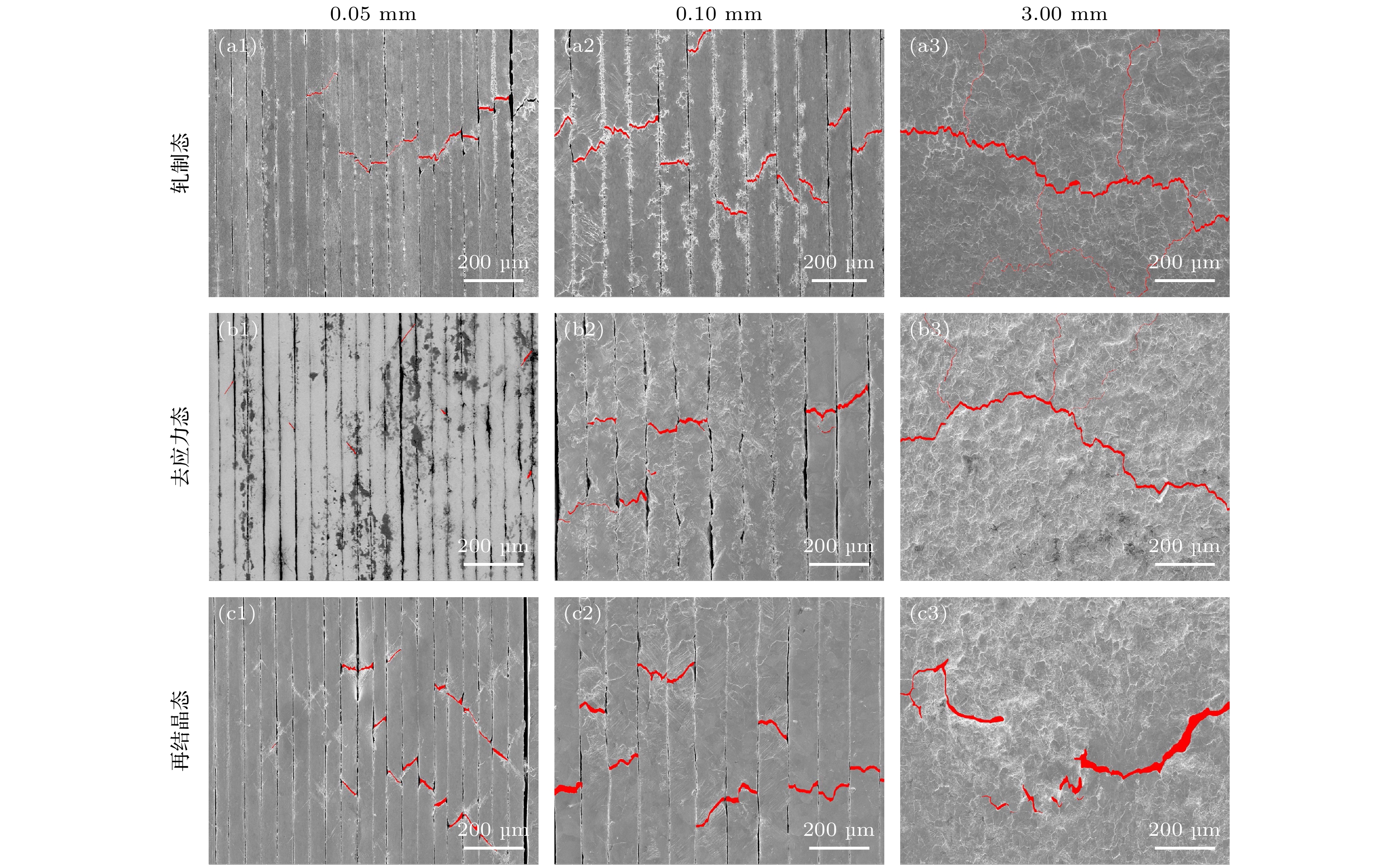
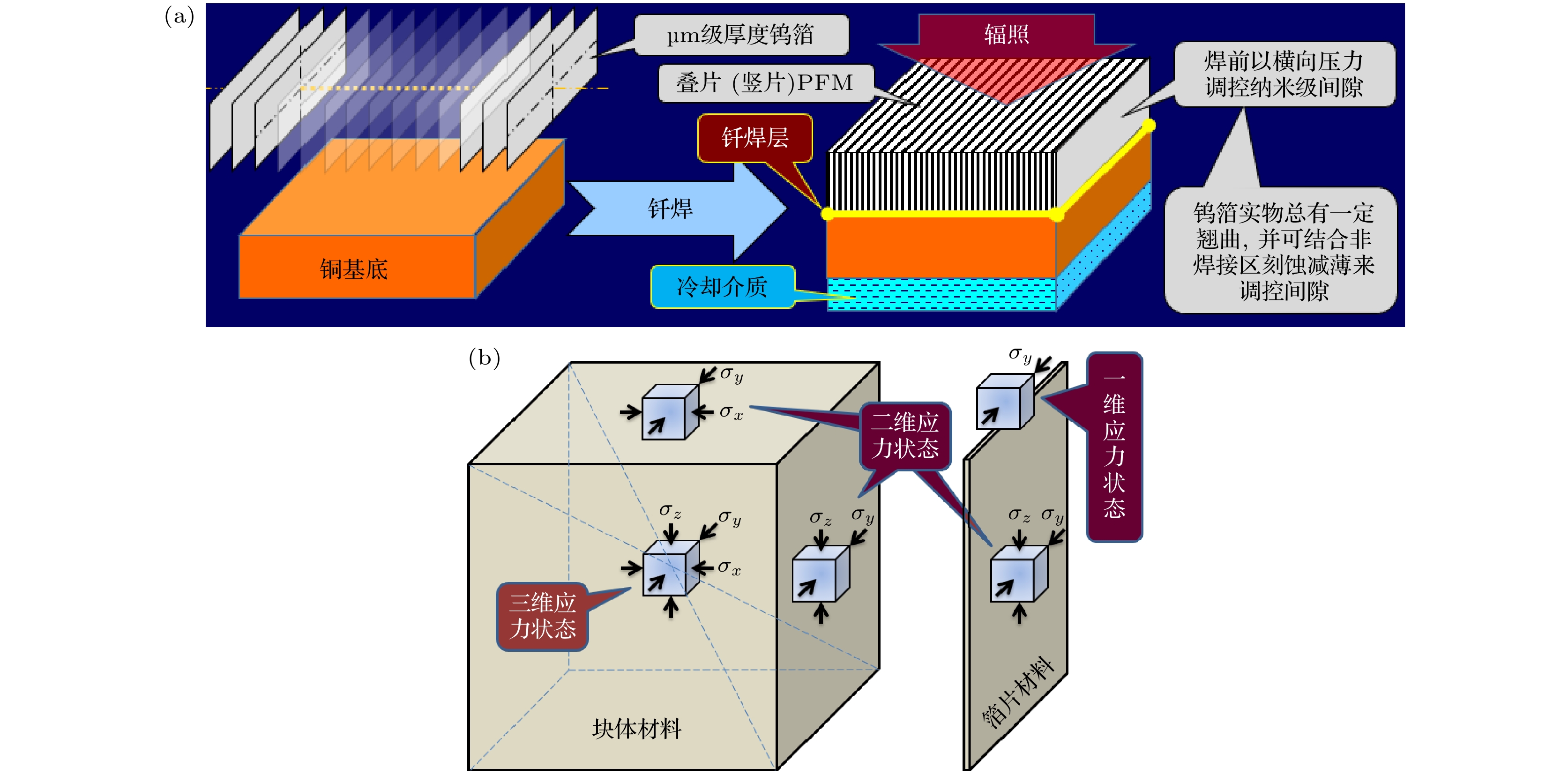
 DownLoad:
DownLoad:
